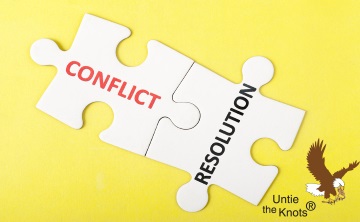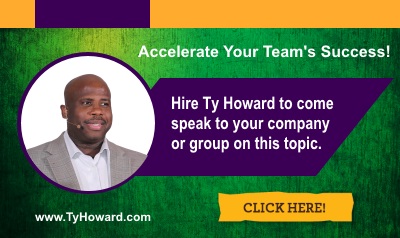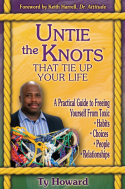Untie the Knots® of the Conflict
Merry-Go-Round at Work

Copyright © 2010 by Ty Howard. All rights reserved.
Do you know an organization that is tied up by the toxic knots of Conflict?
An organization tied up by leadership conflicts, teamwork conflicts, customer service conflicts, gender conflicts, diversity conflicts, gossip conflicts, morale conflicts, rumor mill conflicts, inappropriate behavior conflicts, verbal abuse conflicts, policy conflicts, communication conflicts, integrity conflicts... and it goes around-and-around.
Voilà, welcome to the Conflict Merry-Go-Round at Work!
You know what’s even worse: to have the Conflict Merry-Go-Round going around-and-around inside your workplace and not know how to effectively Untie the Knots® of Conflict to make it stop.
Conflict is a fact of life. When a diverse range of people work together every day, conflict is inevitable. Conflict in the workplace is generally the result of serious disagreement or ignored and avoided tension between two people or a group of people. In most cases, conflict in the workplace causes disorder and an uncomfortable work environment. At the very least, it can lead to low morale among staff. At worst, the results can become a very time-consuming and costly problem that can have a severe impact on a company’s overall performance and bottom line.
While conflict, tension and misunderstandings are normal and inevitable, if left unresolved they result in toxic stress, wasted resources, a drop in productivity, team separation, and an increase in employee call outs or misuse of sick time.
The good news? It doesn’t have to be and stay this way. Armed with practical step-by-step strategies and the desire to Untie the Knots® of Conflict at work, you can - over time - stop the Conflict Merry-Go-Round; and in turn, create a healthy, safe, peak performing and harmonious work environment.
Here is a practical step-by-step process for working effectively through conflict in the workplace:
Step 1: Calm down / Cool off period.
Whenever there is a conflict between two people or a group of people at work, separate and allow the people involved to take a "Calm down / Cool off period." The tension level of the conflict should be the barometer to help you to determine how long this period should be.
When emotions and minds become calm and clear, the process of conflict resolution becomes easier to steer (navigate).
Step 2: Set the stage.
Bring the people involved in the conflict to an empty meeting room where you can close the door and block out all possible distractions if the room has windows. Share with them the clear ground rules for the meeting. Make sure your ground rules have a clear and sound method on how communication will go and flow throughout the meeting. Also, let your people know that your goal as the leader of the meeting is to get everything out in the open in a professional, controlled and respectful manner, and to ultimately resolve the conflict moving forward.
Be mindful that as the leader of the meeting, you must lead by example while communicating and orchestrating the meeting in a professional, respectful and non-aggressive (attacking or argumentative) manner.
A conflict resolution stage well set leads to the successful meeting ground rules being met.
Step 3: Tell what’s bothering you using "I messages."
When people share what’s bothering them using "I messages" or "I statements," it unearths and creates the lines of open and honest communication. "I messages" evoke true emotions and feelings behind what’s being said.
An "I message" filled dialogue breaks people through the tension clog of conflict.
Step 4: Each person restates what they heard the other person say.
After each person involved in the conflict shares their "I messages," have the other person(s) restate what they heard that person say. This step creates an opportunity for everyone to gain clarity and understanding of how the tension and conflict came about.
Restating what you heard allows the other person to bring clarity to their words, so no one is left to assume the other person’s behavior or intentions.
Step 5: Define the problem and take responsibility.
Once everything has been openly and honestly communicated in a professional, controlled and respectful manner, it’s now time for all involved to define the problem and take responsibility for their participation in the conflict.
When people define and take responsibility of their part in a conflict situation, they release healthy human intentions to resolve the situation.
Step 6: Brainstorm and evaluate solution options.
The most effective way to end a conflict between the people involved is to empower them to brainstorm and evaluate the solution options that will enable them to resolve their conflict.
People rarely reject solution options they brainstorm and evaluate to resolve their conflict problems.
Step 7: Negotiate down to one solution option, and create an agreement.
It’s great when people involved in a conflict come up with several possible solution options to resolve their conflict. This at least allows those involved to create an Option A, B, or C. In order to make this happen, the conflict participants have to negotiate down to one solution option, and create an agreement to execute the practicing of this one solution option immediately.
People rarely quit on the solution option they negotiate down to and agree on when working to resolve their conflict situation.
Step 8: Affirm, Forgive, or Thank.
Do not expect feelings, emotions and negative attitudes between people involved in a conflict to change immediately after one successful meeting. Depending on the situation at hand, resolving the conflict can often be a time-consuming and laborious process. If and when you make it to this step in working to resolve a conflict between people at work, simply look at it as progress, small victories won.
If you can get the conflict participants to "Affirm" that they will honestly work to uphold their newly instated agreement, that’s a small victory won. If you can get the conflict participants to genuinely "Forgive" one another without you forcing them to do so, that’s a small victory won. If you can get the conflict participants to "Thank" one another for listening caringly to what they had to say and to agreeing to work to resolve and move forward from the conflict, that’s a small victory won. Affirm, Forgive, or Thank are small victories to win and celebrate when it comes to resolving conflict at work.
Successful conflict resolution is always the result of small victories won, over time.
Step 9: Put the agreed upon option into practice.
What good is it to have a negotiated and agreed upon solution option for a current conflict going on inside your workplace, if you do not put it into practice? Just as strategic planning and execution of a new plan (goals and objectives moving forward) is highly important for the success of an entire organization, so rings true for the strategic planning and execution of a new plan (goals and objectives moving forward) to resolve conflict between people at work. Do not leave the agreement to resolve a conflict between the participants involved to mere words in the air and a shake of hands. Type up a short one page agreement of the participants’ agreement, and have everyone present at the meeting to sign and date it. Your agreement should state clearly and briefly what everyone has agreed to and acknowledge that the practicing and follow-through of the solution option is now officially in place.
When resolving a conflict between people at work, you must put into practice along with the initial agreement, a typed, signed and dated action plan. The action plan will act as a recall and coaching tool for everyone involved in the conflict resolution part of the situation.
Step 10: Schedule an impromptu follow-up.
Inform the participants involved in the conflict that there will be an impromptu follow-up to their successful meeting and signed agreement. When it comes to conflict resolution, I prefer an impromptu meet over an announced and pre-scheduled meeting. When participants know there is a pre-scheduled meeting, they often shape up and fly straight long enough to make it to and through the announced pre-scheduled meeting. Just let the participants know that there will be an impromptu follow-up meeting to take place within the next 90 days. In the meantime, you determine when and how you will call the participants back to and into your follow-up meeting.
If you wish to see and evaluate the true impact of your conflict resolution coaching skills and this process, always schedule an impromptu follow-up meeting so the real and true participants show up for the conflict follow-up session. This method will allow you to effectively gage if the conflict is completely over, or if you still have more conflict coaching to do until the situation is completely resolved.
Initially, this entire process may be extremely time-consuming and frustrating for everyone involved, yet, it needs to be done. If it gets too frustrating or you do not feel like you’re making progress, don’t quit on the process. No matter how big or small your conflict may be—you can do something positive and progressive to eventually break your conflict participants free. Stay the course!
Communicate to your entire staff or team that not all conflict is "bad," it can be a driving force for creativity, innovation, and resilient solutions. That’s constructive conflict and should be within everyone’s skill set to navigate. Ask for their positive support and refusal to participate in any way that will make the conflict situation worse. When conflict becomes disruptive, hostile and creates an unsafe environment for people to work in, seek outside help immediately.
When working to Untie the Knots® of the Conflict Merry-Go-Round inside your workplace, be confident that you are moving in the right direction! If you do it right, and are consistent in showing your team that a harmonious work environment can exist and will benefit everyone, your employees will soon become more energized as they feel both empowered and safe. The time and effort you’ve invested will prove worthwhile. And as the dark gloomy cloud of conflict dissipates from over your company’s Conflict Merry-Go-Round, you will gain more and more control of slowing it down and eventually bring it to a stop. You will also find yourself feeling empowered, and will realize you built accountability by staying confident and committed to a practical process that enabled you to Untie the Knots® of the Conflict Merry-Go-Round at work.
Remember —
The Conflict Merry-Go-Round May Test Your Workplace,
Leaving It Tensioned and Toxic Inside.
Don’t Ignore It! Never Quit on It! Work to Resolve It!
You May Have Been Delayed, But You’re RARELY Denied.
Make Today THE Day that you introduce and execute the process to—
Untie the Knots® of the Conflict Merry-Go-Round at Work!
About the Author: Ty Howard,
Mr. Untie the Knots®,
Freeing Maximal Business, Performance, and Human Potential Daily
Ty Howard is an internationally recognized authority on organizational and managerial practices that optimize employee performance and success. He is the creator and lead facilitator of the trademarked "Untie the Knots® Optimal Performance Process," and the author of Untie the Knots®: Improving Habits, Choices, People, Relationships, Performance and Results, as well as dozens of published articles on employee and organizational performance and development worldwide. For information on his programs and services, visit: http://www.tyhoward.com.


Click Here to Go Back to the
Articles by Ty Howard Home Page
Copyright © 2001 - 2023 by Ty Howard. All Rights Reserved.
For Personal Use Only.
Commercial use without written permission is NOT allowed.
To inquire about this article or any of Ty Howard’s products, special appearances, book signings or speaking services, contact Ty Howard by e-mail at info@tyhoward.com or visit his web site www.tyhoward.com. You may also reach his business office by telephone at (443) 982-7582.









